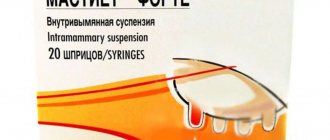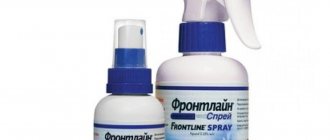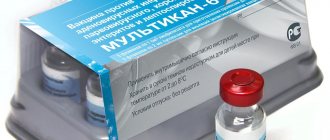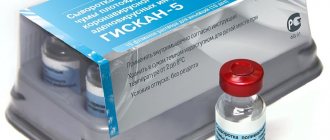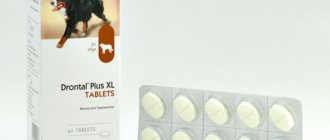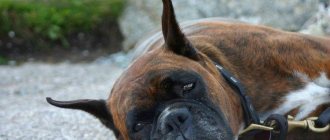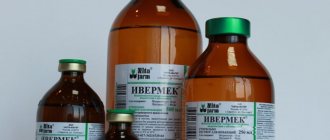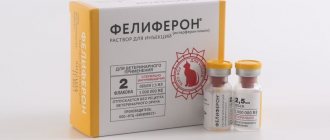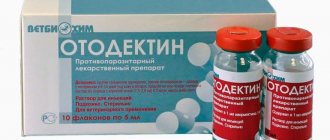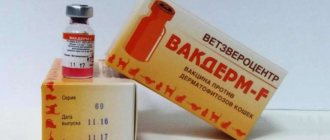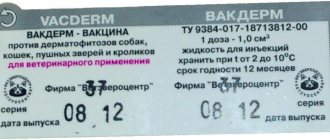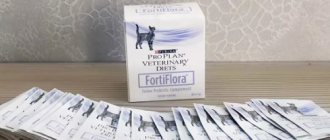Chondoprotector Artroglycan is often prescribed for the treatment of dogs with joint pathologies and simply for the prevention of diseases of the musculoskeletal system. The drug has a good composition, and its cost is in the middle price segment.
But still, with regular use, Artroglycan will cost a pretty penny. Reviews about the medicine are contradictory, so owners doubt whether it is worth buying the medicine.
Let's figure it out together: does Artroglycan help, how does it work, what are its pros and cons, and also what analogues can replace the drug.
Indications for use
Dogs exhibit increased activity throughout their lives.
And this does not always happen without consequences for them. Due to a careless jump, they can get damaged, which can ultimately cause severe arthritis, as well as a number of other associated pathologies. It is customary to talk about the occurrence of this disease when the cartilage, which acts as a layer between the bones, begins to wear away
If you miss this moment and allow the cartilage layer to completely disappear, then the bones will begin to wear away after it.
From the instructions for the drug Artroglycan for dogs it follows that it is capable of restoring cartilage tissue. But the results of official medical studies say otherwise. Therefore, Artroglycan can be considered solely as a feed additive and not as a medicine. It can only reduce pain so that the animal does not feel constrained while moving.
Practice shows that discomfort and pain in the joints appear more often in the following breeds:
- German Shepherds;
- Rottweilers;
- mastiffs;
- Labradors;
- Great Dane
It should be remembered that Artroglycan, like other medications, can cause side effects. Therefore, giving it to animals for preventive purposes is not recommended. You can start introducing this supplement into your dog’s diet only after the following signs appear:
- when touched by the owner, the dog begins to whine;
- does not want to go for a walk in cold weather or in the morning;
- before going up the stairs, he whines and whines;
- licks his joints all the time.
Having discovered any of the above symptoms, the owner should show the animal to the veterinarian, and if he makes such a decision, then he can begin to add an additive to the dog’s food.
Real facts
Judging from the description, after using Arthroglycan in dogs, the amount of synovial fluid should increase, joint pain should go away, bones should become stronger, and worn-out cartilage should be restored. But in reality, this does not happen even with long-term feeding of this nutritional supplement. And there is a scientific explanation for this.
- Degeneration of cartilage tissue is an irreversible process, so the promise of its restoration is initially a deliberate lie.
- The chondroitin molecule is too large to be absorbed unchanged in the intestines and enter the joint. Therefore, it first breaks up into smaller units that can penetrate the bloodstream, and then connects again. However, under the most favorable conditions, no more than 13% of chondroitin is involved in this process, which is then distributed throughout all organs that have cartilage tissue. Consequently, a tiny portion of the drug may reach the affected joint and is unable to have a therapeutic effect.
- It has been clinically proven that the use of chondroprotectors does not lead to an increase in the gap located between the articular surfaces of the bones. And since this indicator indicates an improvement in the condition of the joint, we can confidently speak about the ineffectiveness of the presented drug.
From the above facts it follows that Artroglycan is capable of:
- reduce the permeability of blood vessels;
- reduce the intensity of inflammation and pain in non-infectious joint diseases;
- improve the functioning of the cardiovascular system;
- strengthen bone tissue and prevent osteoporosis.
The rest of the manufacturers' promises about restoring cartilage tissue and joint mobility can be considered an "unfounded exaggeration."
Instructions for use of the drug
The use of Artroglycan is possible if there are appropriate indications; it is necessary to strictly adhere to the dosage and timing of use recommended by the veterinarian.
Composition and pharmacological properties
The active elements of the supplement are the basis of bone and cartilage tissue; these are one of the most popular components in chondoprotectors. Artroglycan contains:
- Chondroitin sulfate, in the amount of 200 mg. It slows down the destruction of bone tissue by blocking enzymes that have a destructive effect on cartilage, reduces calcium loss, and reduces arthritic pain.
- Glucosamine hydrochloride, 100 mg. It stimulates the formation of intra-articular fluid, the synthesis of aminoglycans, and strengthens existing cartilage.
- Selenomethionine, 50 mg. Increases the rate of absorption of the first two elements, maintains tissue elasticity, and slows down aging.
- Calcium gluconate (100 mg) and vitamin E (20 mg) are additional substances that normalize tissue metabolism, have an antioxidant effect, and have a positive effect on the condition of the skeletal system and the overall functioning of the dog’s body.
Effect of the drug
The active components of Arthroglycan increase the rate of restoration of cartilage tissue on the surface of the joints, activate the formation of joint fluid, and strengthen the walls of capillaries. Due to this, the mobility of the affected elements of the skeletal system improves, stiffness is relieved, and pain during movement is reduced.
Also, the active ingredients normalize the amount of calcium, promote muscle gain and slow down destructive processes in bone and cartilage tissue.
Prescribed to dogs with diseases of the spine and joints, such as:
- intervertebral osteochondrosis;
- arthritis;
- osteoporosis;
- arthrosis;
- spondylosis;
- primary arthrosis;
- joint dysplasia;
- osteoarthritis.
It can also be used to prevent degenerative processes of the musculoskeletal system in older pets, obese dogs, females during pregnancy and immediately after it, puppies during tooth replacement, as well as large breed babies.
Dosage, methods and terms of use
- Many dogs eat Artroglycan whole; no special feeding methods are needed.
- If necessary, you can take the upper part of the mouth with your thumb and forefinger and press on both sides where the jaws close. When your pet opens them, place the tablet on the root of the tongue and immediately pour in water from a spoon or syringe without a needle. Next, you should close your mouth and hold it for a couple of seconds, giving the dog the opportunity to swallow the drug.
- You can not use water, but simply lift the animal’s head up and fix it before swallowing.
There are special introducers into which the tablet is placed; when using them, there is no need to place your hand in the mouth.
If the pet is not ready to use the drug on its own, the tablet must be crushed and added to food, or you can dissolve it in water.
As for the dosage and timing, it all depends on the goal:
When solving therapeutic problems, the drug is prescribed for a period of 3 weeks to 3 months. After this, be sure to take a break and repeat the course if necessary. Dosage:
- animal weight up to 40 kg - 1 tablet/10 kg of weight twice a day;
- if the dog weighs more – 4 tablets 2 times a day;
For preventive purposes, the dosage is halved:
- animal weight up to 40 kg - 0.5 tablets/10 kg of weight twice a day;
- for larger dog weights – 2 tablets 2 times a day.
To prevent age-related changes, the drug begins to be given from 6–7 years, and if the breed is at risk, then from 3–4 years.
Contraindications and side effects
It has no side effects; isolated episodes of individual intolerance are possible. They manifest themselves in the form of allergic symptoms (itching, irritation, anxiety) and gastrointestinal disorders (vomiting, diarrhea). Consultation with a veterinarian is necessary to replace the drug with an analogue.
The use of Artroglycan is contraindicated in case of infectious diseases of the musculoskeletal system.
Advantages and disadvantages
Artroglycan has several significant advantages:
- the drug improves the condition of the joints and at the same time strengthens the walls of blood vessels, normalizes the functioning of the liver and heart, and acts as an antioxidant;
- can be given not only to dogs, but also to cats, ferrets and rats - if you have several types of animals, there is no need to select a separate medicine for each;
- one of the key properties of the chondoprotector is stimulation of the production of joint fluid;
- strengthens the entire musculoskeletal system;
- Well tolerated by animals, rarely causes side effects.
However, there are also disadvantages. So:
- allergies are occasionally possible;
- not suitable for the treatment of infectious joint diseases;
- some owners complain of increased bowel movements or diarrhea.
Keep in mind that Artroglycan is not a panacea. It is more of a vitamin supplement than a full-fledged medicine. The main task of the drug is to slow down degenerative processes that have already begun. But not a single chondoprotector is capable of completely restoring articular and cartilaginous tissues.
Read more: Painkillers for dogs.
Owner reviews
Olga: “I have an 11-year-old Labrador with arthrosis and chronic heart failure. They started drinking Artroglycan 1.5 years ago - at that time the dog could barely walk, constantly lay down, walks - 5 minutes near the entrance and then lying down. We started taking 8 tablets a day. After about 3 months, the dog felt better - he began to limp less and walk more. Six months later, only a slight lameness remained, the dog happily walks and gets little rest. The vet advised us to switch to 4 tablets a day for life. I recommend it to everyone: don’t expect an immediate effect, but it’s worth it.”
TamEd. “You need to take the medicine for at least a month for the effect to appear. My dogs with dysplasia eat it for 2 months in a row, then take a break and resume treatment again. Of course, you can’t cope with chondoprotector alone; during exacerbations, I also give painkillers.”
Zelik: “As soon as my German began to limp on his hind leg, I immediately sounded the alarm. The veterinarian recommended a course of Artroglycan and emphasized that we should not expect quick results - the drug has a cumulative effect. But after two weeks the dog began to “pace” faster and run without obvious dragging of his paws. 3 months after the first course of treatment, the pet became lame again. She gave me medicine again. This time the effect came after 5 days. Since then, we have been taking the medicine during every exacerbation, as well as in the spring and autumn as a preventative measure.”
Characteristics of the drug
Artroglycan belongs to the group of chondroprotectors.
The drug has anti-inflammatory and analgesic effects. With its help, metabolic processes in cartilage tissues are normalized, the activity of the liver and heart is stabilized, and the condition of bones and joints is improved.
Who is it for?
The drug is prescribed to animals:
- who have undergone surgery;
- after injuries and fractures;
- elderly pets who are overweight;
- for diseases of the joints and spine;
- pregnant dogs;
- for puppies during the period of change of milk teeth to permanent ones;
- representatives of breeds that have leg problems at the genetic level (Pekingese, Dachshunds, Labradors, Collies, Molossians and Shepherds).
Compound
The drug contains the following components:
- chondroitin sulfate is the main active substance that prevents the leaching of calcium from bones and helps maintain tissue strength;
- glucosamine chloride is designed to restore cartilage tissue;
- selenomethionine strengthens the animal’s body;
- Vitamin E has antioxidant properties, protects bone tissue from damage at the cellular level;
- Calcium gluconate normalizes metabolic processes in tissues.
How to give to an animal
Artoglycan is a feed additive. It is mixed into the animal's food.
It is also possible to take tablets in their pure form. They are placed in the animal’s mouth and held for a few seconds so that the dog can swallow the drug.
Purpose
Artroglycan is prescribed for chronic pathologies of the musculoskeletal system. Most often they affect large breed animals that experience increased stress on their joints. In addition, with age, joints begin to deteriorate and cartilage tissue depletes in all animals, regardless of breed and size.
Dog owners should be alert if:
- the pet often licks joints;
- whines;
- slowly, as if with effort, he climbs the stairs;
- does not show activity during walks;
- limps, etc.
Often, owners do not immediately pay attention to changes in the pet’s behavior and well-being, so they show the dog to a veterinarian only when degenerative changes have already begun. However, Artroglycan is not recommended for use for prevention: it contains substances that can cause side effects, so the feed additive should be used only as prescribed by a veterinarian as a component of complex therapy.
Indications for use of the drug are:
- arthritis and ostearthrosis;
- arthrosis;
- osteoporosis;
- spondylosis;
- intervertebral osteochondrosis;
- joint dysplasia and other pathologies of the locomotor system.
Important! For preventive purposes, veterinarians sometimes recommend using a food additive for older dogs, overweight animals, pregnant females, and puppies during the period of teeth change.
Arthritis
is an inflammatory disease that begins in the synovial membrane and affects the joint and neighboring organs and tissues, and sometimes the entire body. It is manifested by a general deterioration in the animal’s condition, an increase in temperature, refusal of food, etc. The joint tissues swell, local hyperthermia can be noted.
Follow us
Find out more about your animal's personality on our social networks
If the joints begin to deteriorate, osteoarthritis develops. Complex therapy will help stop the process and restore mobility. Without treatment, the prognosis is disappointing: paralysis, amputation, and possible death.
Arthrosis is a pathological change in the joints associated with damage to cartilage tissue. Various factors can provoke a chronic disease:
- injuries;
- inflammatory processes;
- infectious diseases;
- stressful situations.
When cartilage tissue does not fully perform its protective function, bones rub against each other and the joint capsule loses its elasticity. Every movement causes pain to the pet. This leads to limited movement and an increased risk of further injury.
The drug is not able to grow damaged cartilage, but it:
- slows down the progression of destructive processes;
- accelerates the recovery process after joint surgery;
- relieves pain.
Clinical studies and observations of animals have shown that positive dynamics become noticeable after 6-8 weeks of treatment with the drug.
Dosage calculation
If the presence of the disease is confirmed, Artroglycan should be given to the animal in the following dosages:
- for puppies up to 1 year - half a tablet once a day;
- animals weighing from 10 to 30 kg - one tablet per day per 10 kg of weight;
- for animals weighing over 40 kg - two tablets twice a day.
For animals weighing 50 kg, the dosage should be no more than 4 tablets per day. If you neglect this recommendation, it may cause an overdose.
By regularly adding the drug to animal feed, the following positive effects can be achieved:
- relieve the animal from pain while walking;
- avoid surgical intervention if hip dysplasia is confirmed;
- accelerate joint healing after surgery;
- slow down the development of joint diseases;
- restore superficial damaged areas of cartilage.
Based on the results of the studies, it was possible to establish that the effect of the drug begins to manifest itself no earlier than 6-8 weeks from the start of taking the medication to the animal. The exact duration of treatment is chosen by the veterinarian, focusing on the symptoms present in the animal and the dynamics of improvement in the condition.
Indications
The liver is a unique organ that performs quite complex biochemical functions, including the breakdown of nutrients isolated from food into coenzymes suitable for absorption by the body. It also produces essential amino acids, enzymes, platelets, vitamins, proteins and cholesterol. But the most important function of the gland is detoxification. It is the liver that takes the brunt of the impact when toxins of organic or inorganic origin enter the dog’s body.
Hepatovet is a suspension that helps not only to regenerate damaged liver cells, but also to cure congenital and acquired disorders, as well as speed up the recovery of the dog’s body after endo- and exotoxicosis.
The instructions for Hepatovet for dogs say that the suspension can be used if the dog has the following symptoms:
- change in the color of the whites of the eyes (yellowing);
- discolored, oily stool;
- vomit;
- belching of bile;
- loss of appetite;
- bloating (not just in puppies).
For prevention, the suspension can be given to absolutely all dogs that are regularly treated with insecticides (for fleas and ticks), as well as pesticides (for internal parasites). Also, the liver is very negatively affected by preservatives, dyes and synthetic additives contained in low-quality feed.
In consultation with your veterinarian, Hepatovet can be given to dogs undergoing treatment with steroids or cortisone. Since the above medications directly affect the liver, the suspension will significantly reduce the degree of damage.
Composition of Artroglycan for dogs
Having read that the drug contains components that form joint fluid, as well as stimulate its production by the dog’s body.
It can be assumed that Artroglycan is able to restore the full functioning of joints and stop the degenerative processes that occur in them under the influence of increased stress or metabolic disorders.
Chondroitin sulfate
The main active ingredient of the drug is chondroitin sulfate. This component makes up the bulk of synovial fluid, which is a kind of intra-articular lubricant, which:
- prevents the heads of bones from touching and rubbing against each other;
- prevents drying, cracking and degeneration of articular cartilage;
- acts as a shock absorber for the joint during movement;
- nutrition of cartilage tissue.
Synovial fluid is a viscous mucus-like mass consisting of proteins and glycosaminoglycan carbohydrates dissolved in water, the main of which is chondroitin sulfate. Normally, it is constantly synthesized by the joint capsule, ensuring good joint function.
For its formation in the body, the presence of glucose, glutamine (amino acid) and sulfur is necessary. The absence of at least one of the listed components leads to the development of chondroitin deficiency, making it impossible to produce adequate intra-articular fluid.
Glucosamine hydrochloride
This component is part of the chondroitin sulfate molecule, so its synthesis is a necessity.
Insufficient production of glucosamine leads to disruption of the concentration of chondroitin sulfate in the synovial fluid, leading to a decrease in its total volume. This creates additional stress on the cartilage, making it thinner, which reduces shock absorption and provokes irreversible changes in the joints.
Selenomethionine
This selenium derivative is a powerful antioxidant that neutralizes active oxygen ions that accumulate on the surface of cell membranes and lead to their premature destruction.
A sufficient supply of selenomethionine strengthens the immune system of dogs, suppresses the formation and development of cancer cells.
Tocopherol
Vitamin E takes part in the formation of new cells and prevents the premature death of existing ones due to its high antioxidant activity.
A deficiency of this vitamin in adult animals is manifested by disorders of the cardiovascular system, weakening of skeletal muscles, and the development of edema and lameness.
Puppies experience growth retardation, muscular dystrophy, paralysis and increased susceptibility to infectious diseases due to decreased immunity.
Important! The use of preparations containing vitamin E should be combined with feeding vegetable or animal fats. This is explained by the fact that tocopherol is a fat-soluble compound that, without fat, is not absorbed in the gastrointestinal tract of dogs.
Calcium gluconate
This component is included in the drug Artroglycan to prevent the development of bone tissue dystrophy and joint atrophy. It also helps relieve inflammation and stop bleeding by reducing the permeability of blood vessels.
Important! Calcium is well absorbed in the presence of vitamin D. But uncontrolled feeding of nutritional supplements containing this substance is dangerous, as this can cause the opposite effect and lead to calcium leaching, bone fragility, fractures and curvature of the limbs
What effect does it have on the dog’s body?
The drug has the following effects:
- restores tissue;
makes joints more mobile;- inhibits the process of wear of joint tissues;
- stimulates fluid synthesis in joints;
- strengthens the walls of blood vessels;
- stimulates the growth of muscle tissue;
- helps maintain normal calcium concentration in bones;
- prevents the development of rickets in puppies and pathologies with movement in adult dogs;
- normalizes the functioning of the liver and cardiovascular system.
Price and analogues
Artroglycan cost:
- pack of 30 tablets – 280 rubles;
- pack of 300 tablets – 2200 rubles.
Similar chondroprotective drugs: Chondrocan, Chondroitin, Chondartron, Chondrolone, Bonharen, Stride and Stride plus, Artrofit, Gelacan.
Analogs: Biolysin Artro, Tsamaks.
In the article I talked about a product used for cats and dogs, and sometimes for humans, artroglycan. She described the active components of the drug and the form in which it is produced.
She explained in what cases it is used, how it works, and what side effects it causes. She gave contraindications for use, the price of the drug, expiration dates, analogues and storage conditions.
Contraindications and side effects
Note that it is advisable to give Artroglycan to dogs in spring or autumn.
The remedy is especially suitable for those individuals who have had to live for some time in unfavorable conditions, have a poor diet, etc. Many people wonder whether diarrhea can occur after taking this remedy. It must be said that such a symptom is extremely rare in veterinary practice. Often, if the dog is treated correctly, it tolerates this drug calmly. This sign indicates that the dog has gone too far with the dosage or if he is allergic to the components of the medicine. Also, in case of allergies, the animal may shake, and vomiting is also possible. However, such cases are very rare. To summarize, it must be said that Artroglycan for dogs is an effective remedy that helps animals with problems with joints and bones. The medicine must be stored in a dry place, away from moisture and sunlight. The shelf life is 2 years. The cost of the drug is 160 rubles. I must say that it is much cheaper than its analogue, Stride. Although they have the same effects. Which drug to choose depends solely on the individual characteristics of the animal’s body, disease, and other factors.
Analogs of Arthroglytican for cats
If Artroglycan does not suit your cat’s composition, then it is advisable to choose its analogues.
Similar in action are:
- —Felvit Chondro. The tablets are produced by a Czech company. They are suitable for both kittens and adult animals. Provides good joint mobility and prevention of inflammatory processes. Price about 530 rub.
- -Superflex. The drug is produced in liquid form. It is very convenient to give to kittens, simply mixed with liquid food. Perfectly helps the animal recover after fractures and operations. Cost from 1290 rub.
- —Stride plus. Has an analgesic and antipyretic effect. Like the previous sample, it is available in the form of a liquid additive. Price 1790 rub.
- -Polegen. It has become the most inexpensive medicine for strengthening cartilage and bones; it contains beta-carotene and zinc. In addition to its beneficial effects on the musculoskeletal system, the drug takes care of the cat’s skin and coat. Its cost is from 80 rubles.
Also, some manufacturers have made chondroprotectors in the form of treats. One of the most famous is Glyco Flex III. This option is very convenient to give to your pet.
And the American Joint Max produces the medicine in powder form, which is easy to dilute in water or mix into your cat’s food.
Important: The treatment process with chondroprotectors takes quite a long time, so you should be patient and wait for your pet to recover
Drugs similar in action
The most popular ones are listed below, as well as the differences in composition (if not stated separately, they contain chondroitin, glucosamine, calcium):
- Tsamax - contains seaweed, collagen, ascorbic acid, sulfur, etc. There are no similar elements to Artroglycan. Not recommended for white animals.
- Biolysin Artro also contains vitamins B, D, A, K, minerals, folic acid, collagen, biotin. Selenium is missing. Contains a lower dose of chondroitin. As a rule, it is prescribed for large breeds of dogs. Not recommended for puppies under 6 weeks of age.
- Stop-Arthritis (suspension) – no selenium, calcium, vitamin C, plant extracts.
- Chondrocan is a powder that additionally contains collagen, vitamins A, E, C, magnesium and phosphorus.
- Bonharen is a substance for intravenous or subcutaneous use, the active ingredient is hyaluronic acid. Does not contain common substances with artroglycan. For large breed dogs.
- Stride is a powder that does not contain selenium or calcium, but also contains hyaluronic acid. For large breeds.
- Chondrolone is a substance for the preparation of injections, recommended for large breeds, containing only chondroitin.
- Gelacan - does not have common components with Artroglycan, the active ingredients are hyaluronic acid, glycine, proline. Often used for small breed dogs.
- Chondartron - drops or solution for injection. Contains plant extracts, sulfur, calcium, bee venom, lithium carbonate. Does not contain chondroitin, glucosamine, selenium.
- Pro Bio Omega 2500 is a complex vitamin preparation. Chondroitin is missing. Contains glucosamine, probiotics, polyunsaturated fatty acids, and vitamins. For medium and large breeds.
The use of Artroglycan will help to effectively solve your pet’s health problems if there are appropriate indications, as well as prevent their occurrence. By following the veterinarian's recommendations regarding timing and dosage, the owner will be able to help his pet live an active and long life without experiencing pain or discomfort from movements.
Characteristics of Artroglycan
It is a feed additive. Artroglycan is a chondroprotector that, in addition to the functioning of the musculoskeletal system, also improves the condition of the liver and heart of dogs. Can be used for cats. This is a yellowish powder, compressed into tablets of 0.7 grams. They practically do not dissolve in hot and cold water. Pills are packaged in 30 and 300 pieces. The main components of Artroglycan are glucosamine hydrochloride; chondroitin sulfate; vitamin E; calcium; selenomethionine.
The pharmacological effect of the drug is chondroprotective, anti-inflammatory, analgesic. In addition, the drug also has antioxidant activity. It strengthens the walls of capillaries. The drug accelerates regeneration processes, slows down the degeneration of cartilage tissue, restores the joint capsule and cartilaginous surfaces of the joints, stimulating the production of fluid in them. The drug significantly improves joint mobility. It promotes the production of the basic substance of cartilage and bone tissue. The instructions inform that the veterinary drug takes part in the synthesis of proteoglycans, hyaluronic and chondroitinsulfuric acid. It normalizes calcium deposition in bone tissue.
Artroglycan is used by veterinarians to treat diseases of the spine and joints in domestic animals, in particular, primary arthrosis and intervertebral osteochondrosis, spondylosis, osteoarthritis, osteoporosis, and joint dysplasia.
The instructions recommend storing the veterinary drug in a cool place, out of reach of children, for no longer than 24 months.
Content
1. General description 2. Composition and action 3. Purpose 4. Dosage 5. Limitations 6. Price and analogues 7. Video: 8. Reviews
Increased stress on the joints, excess weight, dietary errors that lack important nutritional components and minerals - all this leads to the development of arthritis in pets and other problems with the musculoskeletal system. Artroglycan for dogs is a feed additive that is used to restore cartilage.
Properties and composition of the drug
“Artroglycan” does not refer to drugs, but to feed additives. Its main active components are glucosamine and chondroitin - natural substances that make up cartilage tissue. Glucosamine strengthens cartilage, and chondroitin prevents its destruction by blocking the corresponding enzymes.
In young and healthy dogs, the body produces glucosamine on its own, but with age its production slows down. Both active substances are also found in food, but their quantity there may be insufficient, especially if we are talking about poorly balanced natural food or industrial economy-class food.
The product also contains calcium gluconate and antioxidants: vitamin E and selenomethionine. These substances improve the absorption of fatty acids, slow down the aging process, and maintain tissue elasticity. Selenium contained in selenomethionine accelerates the absorption of glucosamine and hodroitin by 20%.
In general, Artroglycan has the following effects:
- relieves pain and inflammation in joints, promotes their mobility;
- accelerates the restoration of bone tissue and cartilage;
- strengthens capillaries;
- has a beneficial effect on the heart and liver.
Although at the moment there have been no official studies testing the effectiveness of the drug, numerous reviews from owners indicate a positive result.
The closest analogues of the product are “Tsamaks” and “Biolysin Artro”.
How it works
Artroglycan has 3 main actions. He:
- relieves inflammation;
- reduces joint pain;
- slows down the destructive processes of cartilage and joint tissue.
In general, the drug helps to improve the condition of the musculoskeletal system and normalize the metabolic processes of the osteoarticular system. The drug also partially restores damaged cartilage tissue.
Additional elements - vitamin E and selenomethionine - normalize blood flow and microcirculation in the capillaries. At the same time, they improve the functioning of the heart and liver. When taking Arthroglycan regularly, dogs stop limping and whining due to joint pain, and they are no longer stiff in their movements. Thanks to this, they become active again, enjoy walking outside and playing.
Contraindications and side effects
The feed additive can be purchased without a veterinarian's prescription, so pet owners sometimes abuse the drug. Since the main components are completely natural, there are no contraindications for use (except for individual intolerance and allergic reactions).
Side effects are also extremely rare. Even with an overdose, there is no mortal threat to the health of the pet. Such properties make Artroglycan the safest remedy for the treatment of arthritis and arthrosis in animals. However, in rare cases the following may occur:
- insomnia;
- constant fatigue;
- excessive thirst;
- frequent urination;
- rash (if an allergic reaction occurs).
It is also worth noting that the supplement may not be well tolerated by animals that suffer from diabetes.
Artroglycan for dogs instructions for use
Before giving Artroglycan, it is necessary to coordinate its use with a veterinary specialist who will conduct a full examination and rule out the infectious nature of the inflammatory process.
Dosage
According to the instructions for use, the dosage of the drug is 1 tablet. per 10 kg of dog's live weight.
Important! Dogs whose weight exceeds 40 kg are given 2 tablets 2 times a day. This avoids overdose and makes it easier for owners to feed large amounts of the drug.
The duration of the course of application is 30 days. The veterinarian can make a decision on further use of the product on an individual basis, based on the results of the tests performed.
Important! The maximum duration of therapy can be 3 months. In order to prevent osteoporosis, Artroglycan can be given in a dosage of ½ tablet per 10 kg of animal body weight
The course is 21 days per year. For dogs undergoing significant physical activity or over eight years of age, this course of drug administration is carried out 2 times a year.
In order to prevent osteoporosis, Artroglycan can be given in a dosage of ½ tablet per 10 kg of animal body weight. The course is 21 days per year. For dogs undergoing significant physical activity or over eight years of age, this course of drug administration is carried out 2 times a year.
How to give the drug
Having determined the exact weight of the animal and calculated the dosage of the biological additive, you can begin feeding it. It is better to add the crushed drug to a small portion of food. For pets accustomed to ready-made food, this can be pate, and for lovers of natural products, minced meat.
Helpful information! Even picky eating pets love the smell of fish oil. Therefore, you can make the feeding process easier by adding 1 drop of a “treat” to the food, which will simultaneously serve as a source of fat and vitamin D.
If it is necessary to take more than three tablets, it is worth dividing the dose into 2 doses and feeding the animal in equal portions at regular intervals.
Side effects
When using the drug according to the instructions, no side effects were recorded.
Individual manifestations of an allergic reaction to one of the components of Arthroglycan are possible, which resolve on their own after discontinuation of the drug.
Contraindications for use
Artroglycan has the following contraindications for use:
- degeneration of cartilage or bone tissue caused by exposure to infectious agents;
- intolerance to the ingredients of the drug.
You should not use this biological supplement during periods of exacerbation of chronic infections.
Important! In case of functional failures in the liver and kidneys, you should refrain from feeding the drug. This is due to the fact that Artroglycan promotes the intensive elimination of toxins and free oxygen radicals, which creates additional stress on the affected organs
The use of Artroglycan should not be combined with other products containing chodroprotectors.
Storage
The presented product retains its properties for 24 months from the date of production, subject to storage conditions in the temperature range from 0 to 25.
It is also necessary to exclude:
- violation of the integrity of the packaging;
- getting wet;
- exposure to light and direct sunlight.
The drug should be stored separately from food and medicine intended for humans.
Chondroprotectors - salvation for joints?
The nourishment and hydration of cartilage in the joint occurs with the help of synovial fluid, which contains the already mentioned mono- and polysaccharides. With injury, excessive physical activity or systemic disease, the composition of the synovial fluid may be disrupted. Because of this, it becomes less viscous and can no longer provide slip. Once in the synovial fluid, the components of chondroprotectors help restore its consistency and normal activity of cartilage cells. The joints stop hurting and swelling, their mobility improves. In parallel with taking chondroprotectors, other measures are necessary for the active restoration and nutrition of cartilage - physiotherapy, exercise therapy, anti-inflammatory drugs.
